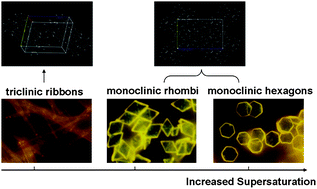A series of rubrene micro-crystals (MCs) with controllable sizes and shapes, ranging from one-dimensional (1D) ribbons to 2D rhombic and hexagonal plates, have bee prepared by employing the reprecipitation method. Based on X-ray diffraction analysis, the crystal structures of 1D ribbons and 2D plates have been identified to be triclinic and monoclinic phases, respectively, rather than the commonly reported orthorhombic phase for vacuum-deposited rubrene crystals. In our system, adjustment of the monomer concentration of rubrene, which in turn determines the supersaturation (β) for crystallization, paved the way for kinetic control over the nucleation and growth processes. Combining with theoretical calculations, we found that transformation from a triclinic phase at low supersaturation to a monoclinic phase at high supersaturation was responsible for the morphology change from 1D ribbons to 2D plates. Both ensemble and single-particle spectroscopy clarifies that 1D ribbons and 2D plates show distinct optical properties, probably related to their different solid-state structures in triclinic and monoclinic crystals. Moreover, scanning near-field optical microscopy reveals that the ribbons show waveguiding along a 1D direction, and the plates in a 2D plane.

